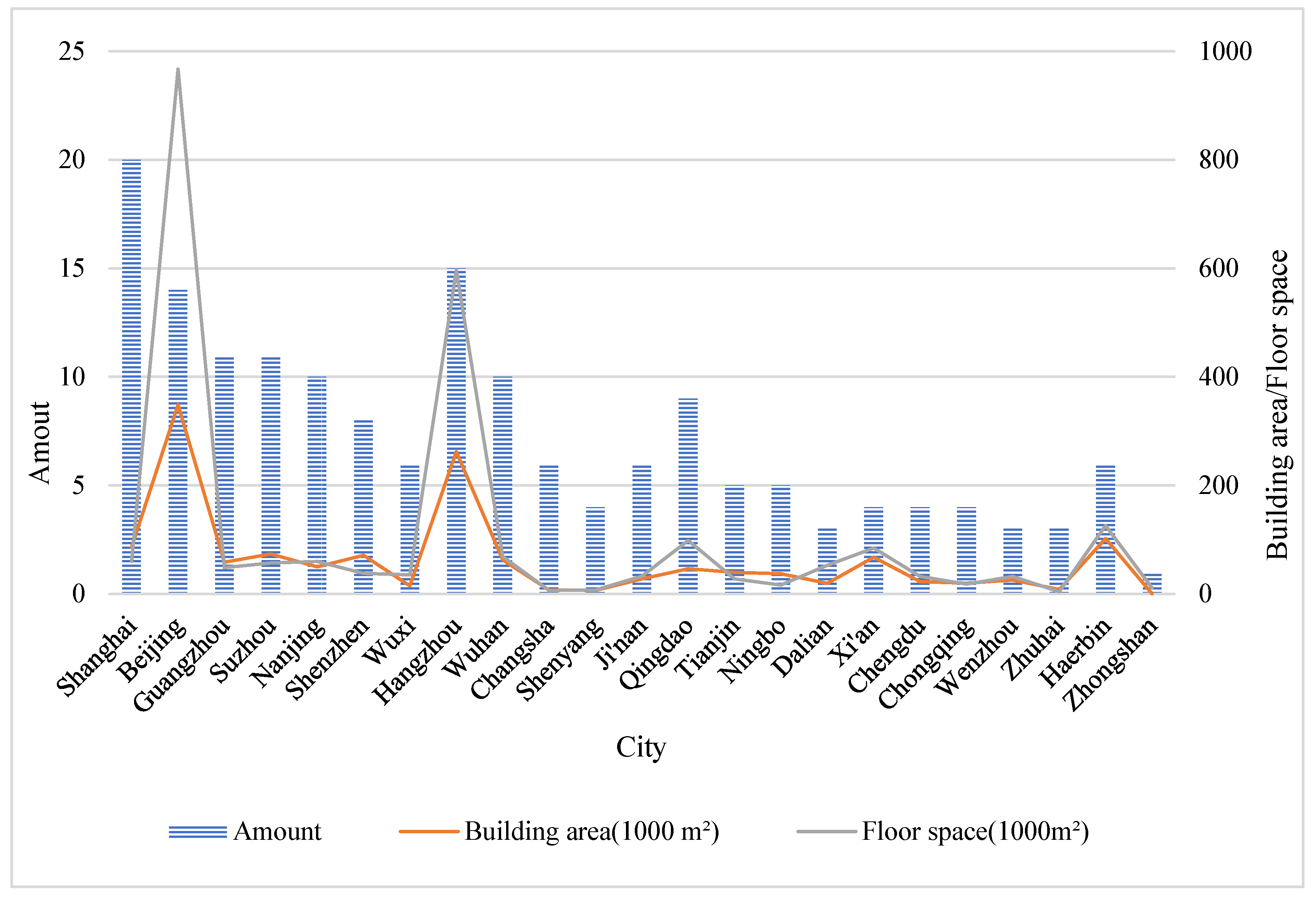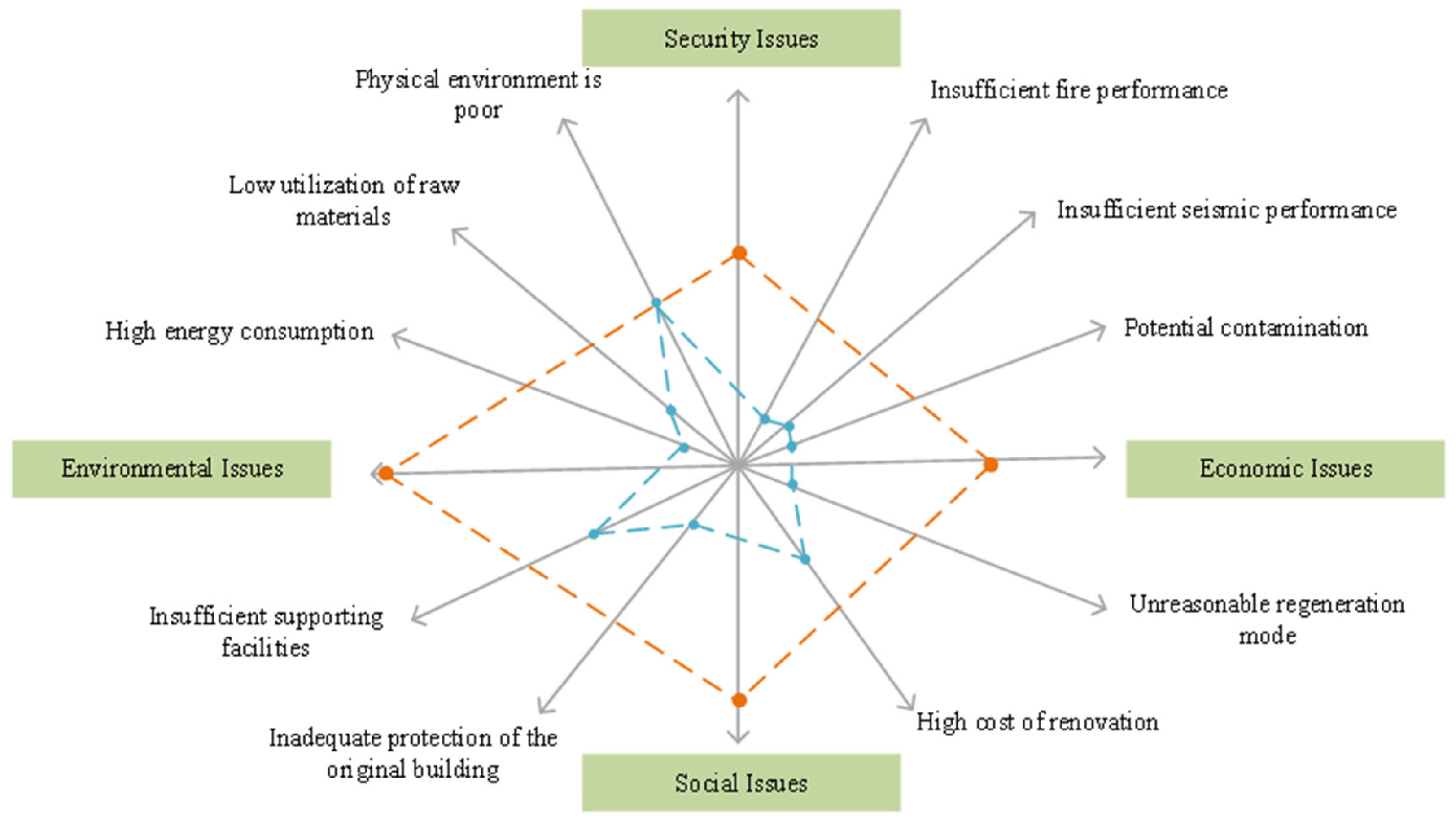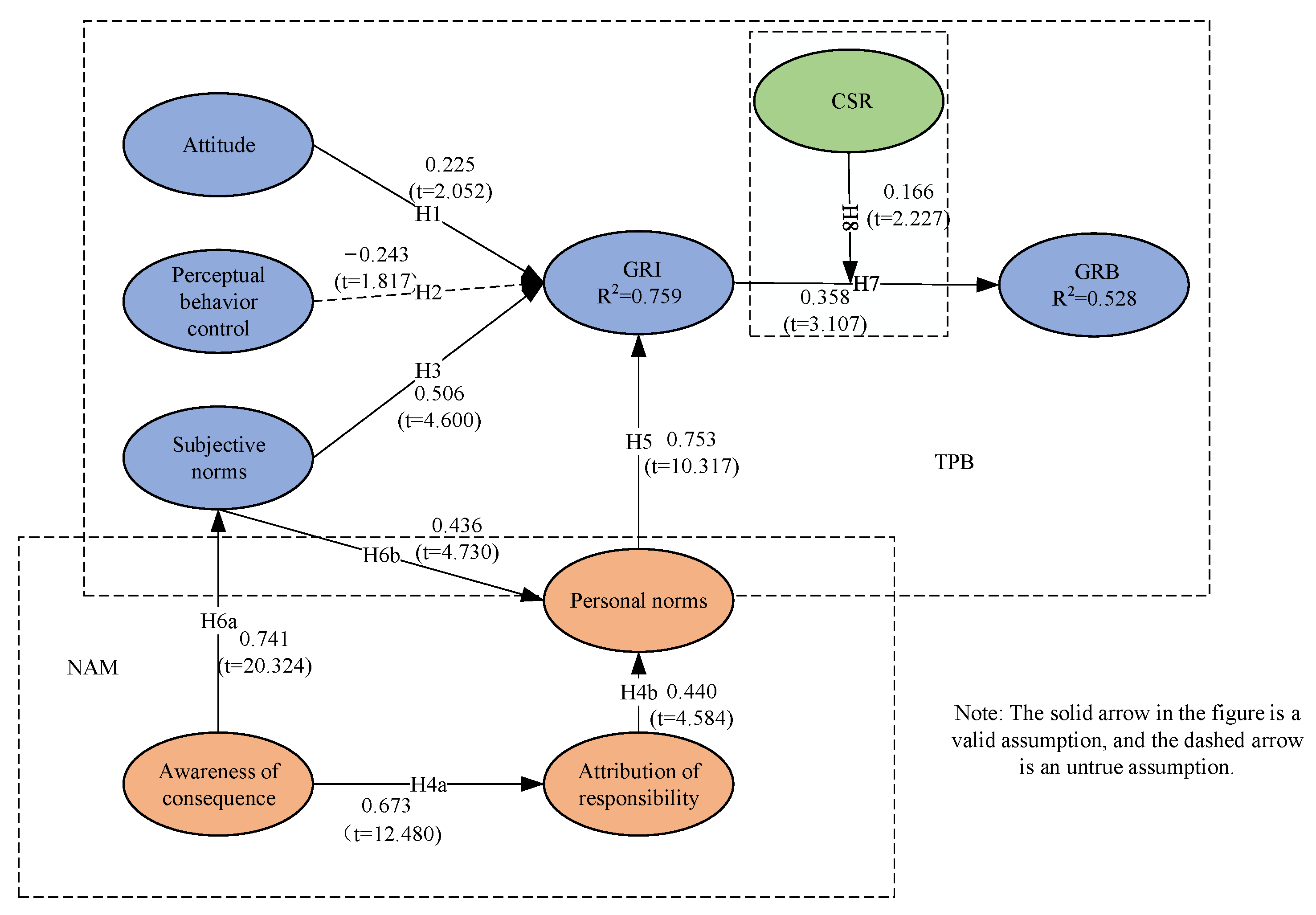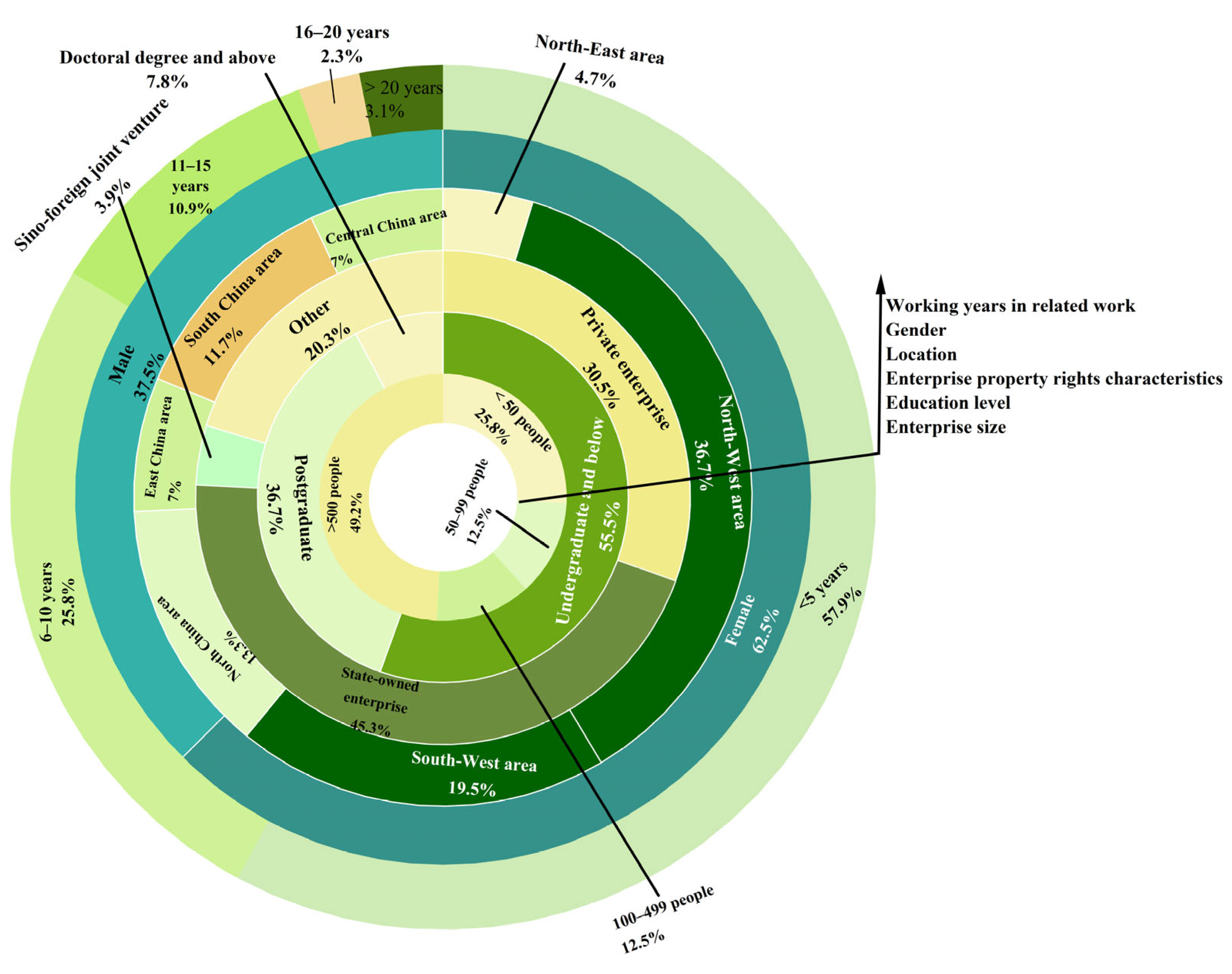Green Redevelopment of Industrial Brownfields: Driving Mechanism and Model
Abstract
:1. Introduction
2. Materials and Methods
2.1. Materials
2.1.1. TPB and NAM
2.1.2. TPB and NAM Integration Theory Hypothesis
2.1.3. Research Hypotheses
2.1.4. Moderating Role between Green Redevelopment Intention and Green
Redevelopment Behavior
2.2. Methods
2.2.1. Questionnaire Design
2.2.2. Data Sources and Sample Characteristics
2.2.3. Research Methods
3. Results
3.1. Reliability and Validity Tests
3.2. Model Structure Verification
3.3. Model Hypothesis Testing
4. Discussion
5. Conclusions
- (1)
- This research integrates the TPB and NAM and constructs a driven model for the GRIB from the dual perspectives of rationality and perceptually. The statistical results showed that the green redevelopment intention of developers is positively affected by three factors, personal norms, subjective norms, and attitude, in a decreasing order of influence. Among them, personal norms have the greatest influence on the GRI, indicating that individuals will inevitably be affected by social norms. Personal norms can directly promote the developers’ GRI (β = 0.750), while the awareness of consequence (β = 0.618) and attribution of responsibility (β = 0.440) will significantly affect the developers’ personal norms, conforming to the basic assumptions of the NAM.
- (2)
- Contrary to previous research by Huang et al. (2021) [37], the influence of perceptual behavior control on the developers’ green redevelopment intention behavior is not statistically supported in this study. This could be due to the complex construction procedures, diverse development models, and numerous participants in industrial brownfield redevelopment projects. As the developers often play the role of project sponsors in the development process, their personal knowledge and technology of green redevelopment have no significant driving effect on the development intention [38]. This is consistent with the research conclusions of Zhang et al. (2017) [39].
- (3)
- The findings revealed that most developers show strong intentions for GRIB; however, in reality, there are still some developers who fail to fulfill the green redevelopment behavior, and the number of developers who fail to fulfill the green redevelopment behavior accounts for 12.7% of the number of people with high development intention (the average score of green redevelopment intention in the scale is more than 4 points, but the green redevelopment behavior is less than 3 points). Research on the introduction of CSR helps understand whether it can promote the conversion of developers’ GRI to GRB, and whether CSR positively regulates the impact of developers’ GRI on GRB. This shows that when developers realize that their company is responsible for green redevelopment, they will have GRI, and their GRB will be stronger.
Author Contributions
Funding
Data Availability Statement
Acknowledgments
Conflicts of Interest
References
- Li, H.M.; Zhang, Y.; Chen, X.; Meng, H.; Zhang, J.; Tian, W. Technical Standard for Green Regeneration of Old Industrial Building, 1st ed.; Metallurgical Industry Press: Beijing, China, 2018. [Google Scholar]
- Zhang, L.; Hu, Q.; Zhang, S.; Zhang, W. Understanding Chinese Residents’ Waste Classification from a Perspective of Intention–Behavior Gap. Sustainability 2020, 12, 4135. [Google Scholar] [CrossRef]
- Pecina, V.; Juřička, D.; Vašinová Galiová, M.; Kynický, J.; Baláková, L.; Brtnický, M. Polluted brownfield site converted into a public urban park: A place providing ecosystem services or a hidden health threat? J. Environ. Manag. 2021, 291, 112669. [Google Scholar] [CrossRef] [PubMed]
- Song, Y.; Kirkwood, N.; Maksimović, Č.; Zhen, X.; O’Connor, D.; Jin, Y.; Hou, D. Nature based solutions for contaminated land remediation and brownfield redevelopment in cities: A review. Sci. Total Environ. 2019, 663, 568–579. [Google Scholar] [CrossRef] [PubMed]
- Tian, W.; Zhong, X.; Guo, P.; Zhang, G. Vulnerability Analysis for Reusing an Old Industrial Area: A Case Study of the Winter Olympic Park. Adv. Civ. Eng. 2021, 2021, 6634875. [Google Scholar] [CrossRef]
- Liu, Y.; Zhu, A.-X.; Wang, J.; Li, W.; Hu, G.; Hu, Y. Land-use decision support in brownfield redevelopment forurbanrenewal based on crowd sourced data an dapresence-and-background learning (PBL) method. Land Use Policy 2019, 88, 104188. [Google Scholar] [CrossRef]
- Zhang, L.; Geng, Y.; Dong, H.; Zhong, Y.; Fujita, T.; Xue, B.; Park, H.S. Emergy-based assessment on the brownfield redevelopment of one old industrial area: A case of Tiexi in China. J. Clean. Prod. 2015, 114, 159. [Google Scholar] [CrossRef]
- Wedding, G.C.; Crawford-Brown, D. Measuring site-level success in brownfield redevelopments: A focus on sustainability and green building. J. Environ. Manag. 2007, 85, 483–495. [Google Scholar] [CrossRef]
- Sołtysik, M.; Katarzyna, M.B. City Space Recycling: The Example of Brownfield Redevelopment. IOP Conf. Ser. Mater. Sci. Eng. 2020, 960, 042016. [Google Scholar] [CrossRef]
- Zhang, G.; Zhang, Y.; Tian, W.; Li, H.; Guo, P.; Ye, F. Bridging the Intention–Behavior Gap: Effect of Altruistic Motives on Developers’ Action towards Green Redevelopment of Industrial Brownfields. Sustainability 2021, 13, 977. [Google Scholar] [CrossRef]
- Ahmad, N.; Zhu, Y.; Lin, H.; Karamat, J.; Waqas, M.; Mumtaz, S.M.T. Mapping the obstacles to brownfield redevelopment adoption in developing economies: Pakistani Perspective. Land Use Policy 2019, 91, 104374. [Google Scholar] [CrossRef]
- Han, Q.; Zhu, Y.; Ke, G.Y.; Hipel, K.W. An ordinal classification of brownfield remediation projects in China for the allocation of government funding. Land Use Policy 2018, 77, 220–230. [Google Scholar] [CrossRef]
- Lai, Y.; Chen, K.; Zhang, J.; Liu, F. Transformation of Industrial Land in Urban Renewal in Shenzhen, China. Land 2020, 9, 371. [Google Scholar] [CrossRef]
- Green, T.L. Evaluating predictors for brownfield redevelopment. Land Use Policy 2018, 73, 299–319. [Google Scholar] [CrossRef]
- Ajzen, I. The theory of planned behavior. Organ. Behav. Hum. Decis. Process. 1991, 50, 179–211. [Google Scholar] [CrossRef]
- Qin, M.; Du, Y.; Wan, X. On the pro-environment willingness of marine fishery enterprises based on TPB-NAM integration. China Popul. Resour. Environ. 2020, 30, 75–83. [Google Scholar]
- Quinton, T.S.; Morris, B.; Trafimow, D. Untangling the Theory of Planned Behavior’s auxiliary assumptions and theoretical assumptions: Implications for predictive and intervention studies. New Ideas Psychol. 2020, 60, 100818. [Google Scholar] [CrossRef]
- Zhang, S.; Hu, D.; Lin, T.; Li, W.; Zhao, R.; Yang, H.; Pei, Y.; Jiang, L. Determinants affecting residents’ waste classification intention and behavior: A study based on TPB and A-B-C methodology. J. Environ. Manag. 2021, 290, 112591. [Google Scholar] [CrossRef] [PubMed]
- Schwartz, S.H. Normative influence on altruism. Adv. Exp. Soc. Psychol. 1977, 10, 222–275. [Google Scholar]
- Kopaei, H.R.; Nooripoor, M.; Karami, A.; Petrescu-Mag, R.M.; Petrescu, D.C. Drivers of Residents’ Home Composting Intention: Integrating the Theory of Planned Behavior, the Norm Activation Model, and the Moderating Role of Composting Knowledge. Sustainability 2021, 13, 6826. [Google Scholar] [CrossRef]
- Meng, B.; Chua, B.-L.; Ryu, H.B.; Han, H. Volunteer tourism (VT) traveler behavior: Merging norm activation model and theory of planned behavior. J. Sustain. Tour. 2020, 28, 1947–1969. [Google Scholar] [CrossRef]
- Yang, S.; Su, Y.; Wang, W.; Hua, K. Research on Developers’ Green Procurement Behavior Based on the Theory of Planned Behavior. Sustainability 2019, 11, 2949. [Google Scholar] [CrossRef]
- Verma, V.K.; Chandra, B. An application of theory of planned behavior to predict young Indian consumers’ green hotel visit intention. J. Clean. Prod. 2017, 172 Pt 1, 1152–1162. [Google Scholar] [CrossRef]
- Wang, L.; Zhang, X. Factors affecting urban residents’ participation in environmental governance: An empirical analysis based on TPB and NAM. J. Hunan Agric. Univ. Soc. Sci. 2017, 18, 92–98. [Google Scholar]
- Guo, Q.-H.; Li, H.; Li, S.; Liu, L. Analysis of the Influence of Personal Norms on Farmers’ Proenvironmental Behavior—Based on the Extended Theory of Norm activation. Resour. Environ. Yangtze Basin 2019, 28, 1176–1184. [Google Scholar]
- Shanka, M.S.; Kotecho, M.G. Combining rationality with morality-integrating theory of planned behavior with norm activation theory to explain compliance with COVID-19 prevention guidelines. Psychol. Health Med. 2021, 28, 305–315. [Google Scholar] [CrossRef] [PubMed]
- Teisl, M.F.; Noblet, C.L.; Rubin, J. The psychology of eco-consumption. J. Agric. Food Ind. Organ. 2009, 7, 1–26. [Google Scholar] [CrossRef]
- Armitage, C.J.; Conner, M. Efficacy of the Theory of Planned Behaviour: A meta-analytic review. Br. J. Soc. Psychol. 2001, 40, 471–499. [Google Scholar] [CrossRef]
- Chen, W.; Wang, C. Air pollution, financial development and the performance of corporate social responsibility. China Popul. Resour. Environ. 2021, 31, 91–106. [Google Scholar]
- Gao, R.; Xu, L.; Chen, S.; Lin, X. The Impact of Transaction Motives and Prevention Motives on the Corporate Cash Holdings under the COVID-19—Based on the Moderating Role of CSR under Extraordinary Circumstances. World Surv. Res. 2022, 6, 62–71. [Google Scholar]
- Guillén, L.; Sergio, A.; Manuel, C. Research on social responsibility of small and medium enterprises: A bibliometric analysis. Manag. Rev. Q. 2021, 72, 857–909. [Google Scholar] [CrossRef]
- Wen, Z.; Hau, K.T.; Chang, L. A comparison of moderator and mediator and their applications. Acta Psychol. Sin. 2005, 37, 268–274. [Google Scholar]
- Mehdi, S.; Mehedi, M.M.; Azin, K. The effect of green human resources management on corporate social responsibility, green psychological climate and employees’ green behavior. J. Clean. Prod. 2021, 313, 127963. [Google Scholar]
- Lopes, J.R.N.; Kalid, R.d.A.; Rodriguez, J.L.M.; Ávila Filho, S. A new model for assessing industrial worker behavior regarding energy saving considering the theory of planned behavior, norm activation model and human reliability. Resour. Conserv. Recycl. 2019, 145, 268–278. [Google Scholar] [CrossRef]
- Fornell, C.; Bookstein, F.L. Two Structural Equation Models: LISREL and PLS Applied to Consumer Exit-Voice Theory. J. Mark. Res. 1982, 19, 440–452. [Google Scholar] [CrossRef]
- Chin, W.W.; Marcolin, B.L.; Newsted, P.R. A Partial Least Squares Latent Variable Modeling Approach for Measuring Interaction Effects: Results from a Monte Carlo Simulation Study and an Electronic-Mail Emotion/Adoption Study. Inf. Syst. Res. 2003, 14, 189–217. [Google Scholar] [CrossRef]
- Huang, Y.; Aguilar, F.; Yang, J.; Qin, Y.; Wen, Y. Predicting citizens’ participatory behavior in urban green space governance: Application of the extended theory of planned behavior. Urban For. Urban Green. 2021, 61, 127110. [Google Scholar] [CrossRef]
- Yang, R.J.; Zou PX, W.; Wang, J. Modelling stakeholder associated risk networks in green building projects. Int. J. Proj. Manag. 2016, 34, 66–81. [Google Scholar] [CrossRef]
- Zhang, X.; Geng, G.; Sun, P. Determinants and implications of citizens’ environmental complaint in China: Integrating theory of planned behavior and norm activation model. J. Clean. Prod. 2017, 166, 148–156. [Google Scholar] [CrossRef]
- Sang, P.; Yao, H.; Zhang, L.; Wang, S.; Wang, Y.; Liu, J. Influencing factors of consumers’ willingness to purchase green housing: A survey from Shandong Province, China. Environ. Dev. Sustain. 2020, 22, 4267–4287. [Google Scholar] [CrossRef]







| Latent Variable | Items | Mean | Standard Deviation |
|---|---|---|---|
| Attitude | Q1 I think GR is worthwhile | 6.625 | 0.559 |
| Q2 I think GR is wise | 6.578 | 0.581 | |
| Q3 I am satisfied with the GR of the current brownfield | 6.586 | 0.580 | |
| Q4 I will work hard to take measures to increase the GR of the enterprise | 6.469 | 0.749 | |
| Subjective norms | Q5 National policy supports the GR treatment of brownfields | 6.047 | 1.082 |
| Q6 Local government supports GR of brownfields | 6.578 | 0.581 | |
| Q7 The industry tends to use GR to industrially treat brownfields | 6.227 | 0.903 | |
| Perceptual behavior control | Q8 I can make independent decisions about GR | 6.133 | 0.947 |
| Q9 I have sufficient knowledge and ability to implement GR | 6.422 | 0.806 | |
| Q10 I have enough time to deal with the difficulties encountered in the process of GR | 6.289 | 0.611 | |
| Awareness of consequence | Q11 Without GR, the environment will be greatly damaged | 5.695 | 1.094 |
| Q12 Without GR, resources will suffer huge waste | 5.938 | 1.066 | |
| Q13 Without GR, public health will be adversely affected | 6.461 | 0.759 | |
| Q14 Without GR, the quality of life of future generations will be affected | 6.367 | 0.738 | |
| Q15 Without GR, sustainable development will be restricted | 6.406 | 0.765 | |
| Q16 GR can be recognized by the public | 6.375 | 0.875 | |
| Q17 GR can get higher returns | 6.352 | 0.787 | |
| Q18 GR can reduce land waste | 6.438 | 0.778 | |
| Q19 Economic compensation can be obtained for GR | 6.344 | 0.956 | |
| Q20 GR behavior helps to minimize damage to the environment | 6.234 | 0.948 | |
| Attribution of responsibility | Q21 As a developer, be responsible for restricting the development of the city by not implementing GR | 5.945 | 1.348 |
| Q22 As a developer, be responsible for the waste of resources caused by not adopting GR | 5.961 | 1.360 | |
| Q23 As a developer, be responsible for environmental problems caused by not implementing GR | 5.859 | 1.440 | |
| Q24 As a developer, be responsible for the bad effects caused by not adopting GR | 5.922 | 1.303 | |
| Personal norms | Q25 Performing GR will make me feel good | 6.195 | 0.952 |
| Q26 I think I have a responsibility to implement GR | 6.133 | 1.041 | |
| Q27 I promise to implement GR and make contributions to improve the environment | 6.156 | 0.972 | |
| Green redevelopment intention (GRI) | Q28 I will tell others about the benefits of GR | 6.102 | 1.014 |
| Q29 If someone else transforms the industrial brownfield, I would recommend a GR strategy | 6.211 | 0.965 | |
| Q30 If I want to develop industrial brownfields, I will adopt the GR strategy | 6.180 | 0.947 | |
| Corporate social responsibility (CSR) | Q31 All companies are jointly responsible for the social environment | 6.266 | 0.906 |
| Q32 Reducing environmental pollution is the responsibility of the company | 6.281 | 0.901 | |
| Q33 Enterprises have the responsibility to lead GR behavior | 6.039 | 1.049 | |
| Green redevelopment behavior (GRB) | Q34 I will tell others about the benefits of GR | 6.031 | 1.118 |
| Q35 When purchasing raw materials, we will try our best to choose green and environmentally friendly materials | 6.000 | 1.053 | |
| Q36 I will actively develop green products and make corresponding plans and schedules | 5.828 | 1.232 |
| Constructs | Items | Std. | T-Value | Cronbach’s α | rho-A | Combination Reliability | AVE |
|---|---|---|---|---|---|---|---|
| Attitude (ATT) | Q1 | 0.703 | 8.798 | 0.732 | 0.742 | 0.830 | 0.549 |
| Q2 | 0.768 | 13.262 | |||||
| Q3 | 0.745 | 11.205 | |||||
| Q4 | 0.748 | 13.573 | |||||
| Subjective norms (SN) | Q5 | 0.734 | 12.979 | 0.771 | 0.777 | 0.775 | 0.537 |
| Q6 | 0.650 | 8.683 | |||||
| Q7 | 0.805 | 19.752 | |||||
| Perceptual behavior control (PBC) | Q8 | 0.824 | 21.574 | 0.760 | 0.782 | 0.846 | 0.579 |
| Q9 | 0.786 | 17.603 | |||||
| Q10 | 0.727 | 10.468 | |||||
| Awareness of consequence (AC) | Q11 | 0.468 | 5.427 | N.A. | N.A. | N.A. | N.A. |
| Q12 | 0.732 | 11.527 | |||||
| Q13 | 0.682 | 8.362 | |||||
| Q14 | 0.643 | 8.900 | |||||
| Q15 | 0.652 | 8.690 | |||||
| Q16 | 0.536 | 4.231 | |||||
| Q17 | 0.606 | 6.231 | |||||
| Q18 | 0.836 | 13.663 | |||||
| Q19 | 0.606 | 4.237 | |||||
| Q20 | 0.855 | 18.219 | |||||
| Attribution of responsibility (AR) | Q21 | 0.917 | 47.167 | 0.954 | 0.955 | 0.967 | 0.878 |
| Q22 | 0.951 | 69.225 | |||||
| Q23 | 0.943 | 60.227 | |||||
| Q24 | 0.938 | 56.708 | |||||
| Personal norms (PN) | Q25 | 0.872 | 26.950 | 0.903 | 0.907 | 0.933 | 0.776 |
| Q26 | 0.906 | 52.855 | |||||
| Q27 | 0.915 | 59.432 | |||||
| Green redevelopment intention (GRI) | Q28 | 0.805 | 17.129 | 0.855 | 0.862 | 0.913 | 0.777 |
| Q29 | 0.925 | 45.370 | |||||
| Q30 | 0.910 | 34.409 | |||||
| Corporate social responsibility (CSR) | Q31 | 0.842 | 16.664 | 0.867 | 0.888 | 0.918 | 0.789 |
| Q32 | 0.922 | 43.696 | |||||
| Q33 | 0.899 | 36.774 | |||||
| Green redevelopment behavior (GRB) | Q34 | 0.935 | 74.577 | 0.886 | 0.899 | 0.929 | 0.814 |
| Q35 | 0.902 | 41.505 | |||||
| Q36 | 0.869 | 23.542 |
| PN | SN | CSR | ATT | PBC | AC | GRI | GRB | AR | |
|---|---|---|---|---|---|---|---|---|---|
| PN | 0.776 | ||||||||
| SN | 0.495 | 0.537 | |||||||
| CSR | 0.702 | 0.430 | 0.789 | ||||||
| ATT | 0.533 | 0.665 | 0.348 | 0.549 | |||||
| PBC | 0.523 | 0.781 | 0.398 | 0.501 | 0.579 | ||||
| AC | 0.726 | 0.660 | 0.531 | 0.609 | 0.642 | N.A. | |||
| GRI | 0.831 | 0.472 | 0.751 | 0.549 | 0.502 | 0.642 | 0.777 | ||
| GRB | 0.613 | 0.459 | 0.690 | 0.322 | 0.524 | 0.546 | 0.666 | 0.814 | |
| AR | 0.677 | 0.398 | 0.619 | 0.323 | 0.432 | 0.551 | 0.525 | 0.505 | 0.878 |
| Hypothesis | Standardization Factor | T-Value | Result |
|---|---|---|---|
| H1: ATT --> GRI | 0.225 | 2.052 ** | Supported |
| H2: PBC --> GRI | −0.243 | 1.817 n.s | Not Supported |
| H3: SN--> GRI | 0.506 | 4.600 *** | Supported |
| H4a: AC--> AR | 0.673 | 12.480 *** | Supported |
| H4b: AR --> PN | 0.440 | 4.584 *** | Supported |
| H5: PN --> GRI | 0.753 | 10.317 *** | Supported |
| H6a: AC--> SN | 0.741 | 20.324 *** | Supported |
| H6b: SN --> PN | 0.436 | 4.730 *** | Supported |
| H7: GRI --> GRB | 0.358 | 3.157 *** | Supported |
| Dependent Variable | Moderator Variable | Independent Variable | Original Sample | T-Value | Result |
|---|---|---|---|---|---|
| GRB | CSR | GRI | 0.166 | 2.227 | Supported |
Disclaimer/Publisher’s Note: The statements, opinions and data contained in all publications are solely those of the individual author(s) and contributor(s) and not of MDPI and/or the editor(s). MDPI and/or the editor(s) disclaim responsibility for any injury to people or property resulting from any ideas, methods, instructions or products referred to in the content. |
© 2023 by the authors. Licensee MDPI, Basel, Switzerland. This article is an open access article distributed under the terms and conditions of the Creative Commons Attribution (CC BY) license (https://creativecommons.org/licenses/by/4.0/).
Share and Cite
Zhang, Y.; Luo, X.; Wang, S.; Liu, C. Green Redevelopment of Industrial Brownfields: Driving Mechanism and Model. Sustainability 2023, 15, 16268. https://doi.org/10.3390/su152316268
Zhang Y, Luo X, Wang S, Liu C. Green Redevelopment of Industrial Brownfields: Driving Mechanism and Model. Sustainability. 2023; 15(23):16268. https://doi.org/10.3390/su152316268
Chicago/Turabian StyleZhang, Yang, Xiaomeng Luo, Shuqing Wang, and Chang Liu. 2023. "Green Redevelopment of Industrial Brownfields: Driving Mechanism and Model" Sustainability 15, no. 23: 16268. https://doi.org/10.3390/su152316268
APA StyleZhang, Y., Luo, X., Wang, S., & Liu, C. (2023). Green Redevelopment of Industrial Brownfields: Driving Mechanism and Model. Sustainability, 15(23), 16268. https://doi.org/10.3390/su152316268






